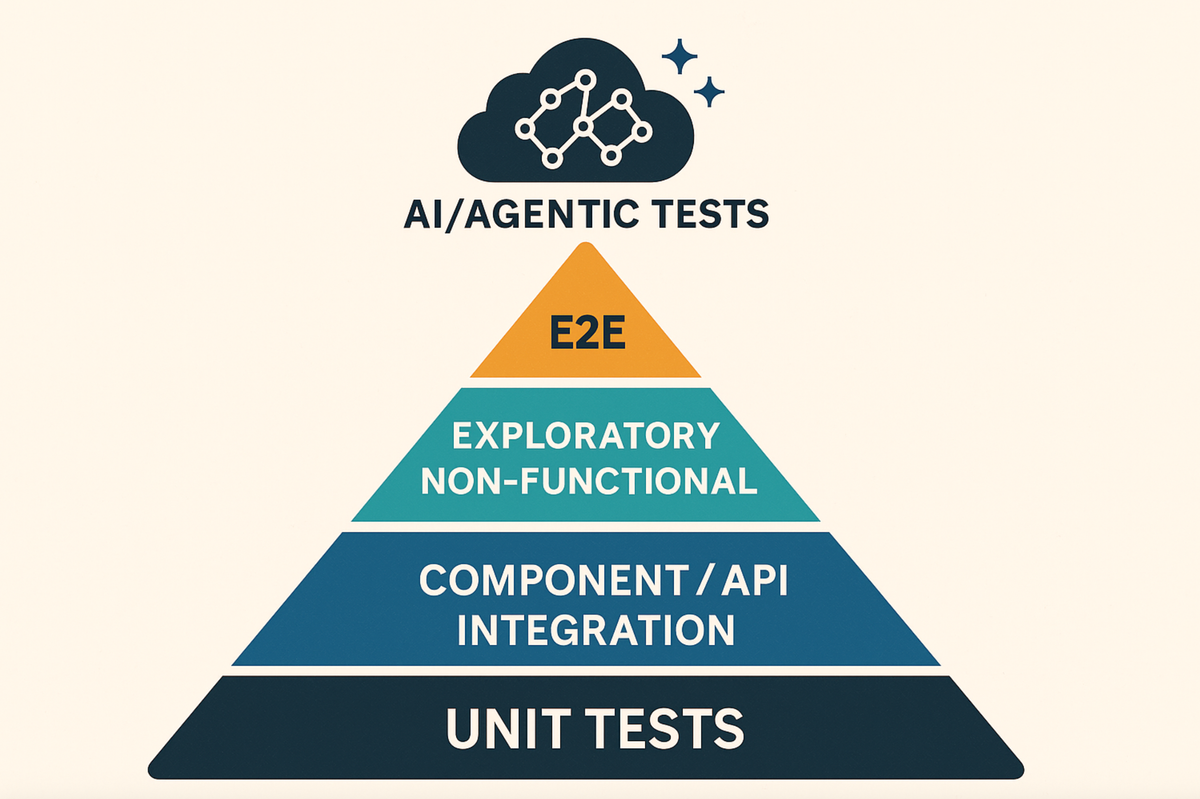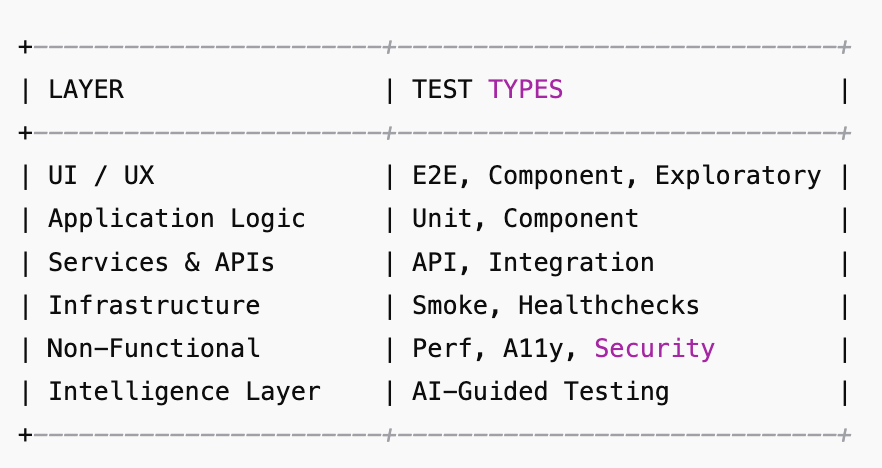The 8 Types of Tests Every Scalable Quality Engineering Strategy Needs

Too many teams jump into end-to-end automation without laying the groundwork for a scalable, layered testing strategy. If you’re trying to build (or rebuild) a modern Quality Engineering (QE) practice, understanding the types of tests you need—and who owns them—is critical.
This post outlines the 8 essential layers of testing that make up a mature QE strategy, from fast feedback to full coverage across systems, APIs, and user journeys.
1.Unit Tests
Owner: Developers
Scope: Single function/method
Speed: Milliseconds
Tools: Jest, PyTest, JUnit, Mocha
Unit tests are your first line of defense. They validate business logic, edge cases, and calculations at the function level. A test might assert that validateDOB() throws an error if a date is in the future. They should run lightning-fast and be part of every pull request.
✅ Aim for ~70–80% code coverage in logic-heavy modules.
2.Component / Module Tests (Manual + Automated)
Owner: QE + Developers
Scope: One screen, widget, or backend feature
Speed: Fast to moderate
Tools: Playwright, Zephyr Scale, Allure TestOps
These tests verify functional correctness within a specific part of the system. They're especially powerful when tied to Figma designs or requirements. For example: “Create Roster screen shows validation error when MRN is missing.”
When automated, they serve as regression guards at the module level. When manual, they allow rapid iteration on new features before investing in automation.
✅ Use these to scaffold your Playwright automation and bridge the manual-automation gap.
3.Integration Tests
Owner: Developers or QE
Scope: Two or more modules/services working together
Speed: Moderate
Tools: REST-assured, PyTest, Supertest
Integration tests ensure that components talk to each other correctly—APIs return expected values, databases are updated, and service chains behave reliably.
Think: “Saving a patient triggers an EHR sync and audit log creation.”
✅ Crucial in systems with microservices or external APIs (like EHRs or payment gateways).
4.End-to-End (E2E) Tests
Owner: QE
Scope: Full user workflow
Speed: Slowest
Tools: Playwright, Cypress, Selenium
These simulate real-world user flows across the frontend, backend, and integrations. For example: “User logs in → selects a patient → schedules an AWV → receives confirmation.”
Because they're slower and more brittle, focus only on high-value flows, not every possible scenario.
✅ 10–15 stable E2E tests can deliver massive value across pre-release validation.
5.API Tests
Owner: Backend developers or QE
Scope: Individual endpoint or sequence
Speed: Moderate to fast
Tools: Postman, PyTest, REST-assured
These tests ensure your APIs return the correct status, payload, and error handling. A typical test might validate that GET /patients returns the correct MRN list for authorized users.
They’re quick to run, easy to scale across environments, and incredibly useful in CI pipelines.
✅ Write these once and run them everywhere. They complement UI tests perfectly.
6.Manual Exploratory Tests
Owner: QE, Product Managers, Designers
Scope: Flexible
Speed: Session-based
Tools: Zephyr, Allure, or plain notes
Exploratory testing is where human creativity shines. It’s ideal for edge cases, usability quirks, and areas not yet automated. It also uncovers subtle UX issues that automation will miss.
Try things like “Use weird characters in a form field,” or “Click through a flow out of order.”
✅ Run exploratory sessions before key releases. Use findings to prioritize bugs and future automation.
7.Non-Functional Tests
Owner: QE, DevOps, Security Engineers
Scope: System-wide attributes
Tools: JMeter, k6, Lighthouse, OWASP ZAP
These tests validate performance, security, accessibility, and system limits.
Subtypes:
- Performance Tests: Load, stress, and spike tests to detect bottlenecks
- Accessibility Tests: Lighthouse or Axe-core audits for WCAG compliance
- Security Tests: OWASP scans, dependency audits, auth flow validation
✅ Bake these into CI/CD early. They're hard to retrofit after incidents.
8. 🧠 AI/Agentic Tests (Emerging)
Owner: QE Innovation Team / Architects
Scope: Dynamic, intelligence-based workflows
Tools: OpenAI, LangChain, custom agents
This new frontier leverages LLMs to generate, triage, and optimize tests. Examples include:
- Converting acceptance criteria or Jira tickets into automated tests
- Running AI agents to identify test coverage gaps
- Auto-triaging failed tests using reasoning chains
✅ Start experimenting in low-risk areas like documentation-driven test generation.
Suggested QE Layering Model

Each layer builds upon the one below it. If you skip a layer (e.g., no API or unit tests), your higher-level tests become bloated and brittle.
Final Thoughts
There’s no one-size-fits-all QA structure, but the most effective QE orgs understand layered ownership, modular architecture, and test ROI.
If you’re just getting started:
- Map your product’s architecture to these test types.
- Assign clear ownership to each layer.
- Start small, and scale intelligently.
If you’re already running Playwright, Zephyr, or Allure TestOps, you’re in a great position to map manual and automated coverage across all of these layers—and even start experimenting with AI.



Comments ()